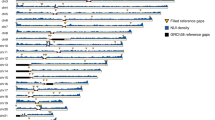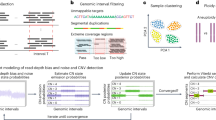Abstract
Using our data set of 3,143 single pass sequences from human brain cDNA libraries, we have developed a strategy in which gene–based sequence–tagged–sites (STSs), derived from 3′untranslated regions of human cDNAs, are rapidly assigned to megabase–insert yeast artificial chromosomes and somatic cell hybrids to generate regional gene mapping data. Employing this approach, we have mapped 318 cDNAs, representing 308 human genes. Ninety–two of these mapped to regions implicated in human genetic diseases, identifying them as candidate genes. Extension of this strategy has the potential to result in virtually every human gene having, at its 3′ end, its own associated STS, with each STS in turn specifying both a corresponding genomic clone and a specific regional location in the genome.
This is a preview of subscription content, access via your institution
Access options
Subscribe to this journal
Receive 12 print issues and online access
$209.00 per year
only $17.42 per issue
Buy this article
- Purchase on Springer Link
- Instant access to full article PDF
Prices may be subject to local taxes which are calculated during checkout
Similar content being viewed by others
References
Wilcox, A.S., Khan, A.S., Hopkins, J.A. & Sikela, J.M. Use of 3′untranslated sequences of human cDNAs for rapid chromosome assignment and conversion to STSs: implications for an expression map of the genome. Nucl. Acids Res. 19, 1837–1843 (1991).
Olsen, M., Hood, L., Cantor, C. & Botstein, D. A common language for physical mapping of the human genome. Science 245, 1434–1435 (1989).
Adams, M.D. et al. Complementary DNA sequencing: expressed sequence tags and human genome project. Science 252, 1651–1656 (1991).
Adams, M.D. et al. Sequence identification of 2,375 human brain genes. Nature 355, 632–634 (1992).
Adams, M.D., Kerlavage, A.R., Fields, C. & Venter, J.C. 3,400 new expressed sequence tags identify diversity of transcripts in human brain. Nature Genet. 4, 256 (1993).
Adams, M., Soares, B., Kerlavage, A., Fields, C. & Venter, J.C. Rapid cDNA sequencing (expressed sequence tags) from a directionally cloned human infant brain cDNA library. Nature Genet. 4, 373–380 (1993).
Khan, A.S. et al. Single pass sequencing and physical and genetic mapping of human brain cDNAs. Nature Genet. 2, 180–185 (1992).
McCombie, W.R. et al. Caenorhabditis elegans expressed sequence tags identify gene families and potential disease gene homologues. Nature Genet. 1, 124–131 (1992).
Okubo, K. et al. Large scale cDNA sequencing for analysis of quantitative and qualitative aspects of gene expression. Nature Genet. 2, 173–179 (1992).
Polymeropoulos, M.H. et al. Chromosomal assignment of 46 brain cDNAs. Genomics 12, 492–496 (1992).
Polymeropoulos, M.H. et al. Chromosomal distribution of 320 genes from a brain cDNA library. Nature Genet. 4, 381–386 (1993).
Sikela, J.M. & Auffray, C. Finding new genes faster than ever. Nature Genet. 3, 189–191 (1993).
Waterston, R. et al. A survey of expressed sequence tags from C. elegans. Nature Genet. 1, 114–123 (1992).
Bellanné-Chantelot, C. et al. Mapping the whole human genome by fingerprinting yeast artificial chromosomes. Cell 70, 1059–1068 (1992).
Cohen, D., Chumakov, I. & Weissenbach, J. A first generation map of the human genome. Nature 366, 698–701 (1993).
OMIM(™)[database online]. Johns Hopkins University; Baltimore, MD. (searched August, 1994-December, 1994).
Cox, D.R., Burmeister, M., Price, E.R., Kim, S. & Myers, R.M. Radiation hybrid mapping: a somatic cell genetic method for constructing high-resolution maps of mammalian chromosomes. Science 250, 245–250 (1990).
Collins, F.S. Positional cloning moves from perditional to traditional. Nature Genet. 9, 347–350 (1995).
Soares, M.B. et al. Construction and characterization of a normalized cDNA library. Proc. natn. Acad. Sci. U.S.A. 91, 9228–9232 (1994).
Boguski, M. dbEST: a database of expressed sequence tags. Nature Genet. 4, 332–333 (1993).
Benson, D., Lipman, D.O. & Ostell, J. Genebank Nucl. Acids Res. 21, 2963–2965 (1993).
Lincoln, S.E., Daly, M.J. & Lander, E.S. PRIMER: a computer program for automatically selecting PCR Primers, Version 0.5, The Whitehead Institute for Biomedical Research(1991).
Goold, R.D. et al. The development of sequence-tagged sites for human chromosome 4 [see comments]. Hum. molec. Genet. 2, 1271–1288 (1993).
Reid, T., Baldini, A., Rand, T.C. & Ward, D.C. Simultaneous visualization of seven different DNA probes by in situ hybridization using combinatorial fluorescence and digital imaging microscopy. Proc. natn. Acad. Sci. U.S.A. 89, 1388–1392 (1992).
Weber, J.L. et al. Evidence for human meiotic crossover interference obtained through construction of a short tandem repeat polymorphism linkage map of chromosome 19. Am. J. hum. Genet 53, 1079–1095 (1993).
Author information
Authors and Affiliations
Rights and permissions
About this article
Cite this article
Berry, R., Stevens, T., Walter, N. et al. Gene–based sequence–tagged–sites (STSs) as the basis for a human gene map. Nat Genet 10, 415–423 (1995). https://doi.org/10.1038/ng0895-415
Received:
Accepted:
Issue Date:
DOI: https://doi.org/10.1038/ng0895-415
This article is cited by
-
The human homologue of the RNA polymerase II-associated factor 1 (hPaf1), localized on the 19q13 amplicon, is associated with tumorigenesis
Oncogene (2006)
-
Initial sequencing and analysis of the human genome
Nature (2001)
-
HOSEpipE—a WWW-hosted data management and analysis system for STS content mapping projects
Mammalian Genome (1997)
-
Identification and mapping of human cDNAs homologous to Drosophila mutant genes through EST database searching
Nature Genetics (1996)
-
A gene mutated in X–linked myotubular myopathy defines a new putative tyrosine phosphatase family conserved in yeast
Nature Genetics (1996)



